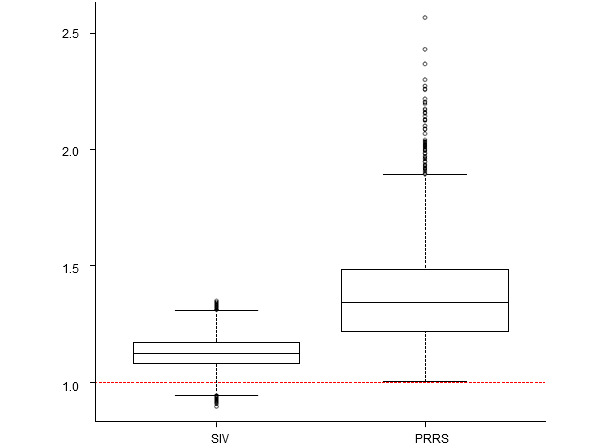Given the ubiquitous distribution of the swine influenza virus (SIV) and difficulties associated with its control in breeding herds, likelihood of infection for a pig throughout his productive life is very high. Even though direct impact of SIV infection in terms of mortality is considered limited (<1%), other factors such as the immune status of the animal when the infection takes place, or the presence of other pathogens, can lead to an increased effect on mortality. If the infection occurs during the suckling period, maternal antibodies can decrease the impact of the infection compared with what could be expected when it happens in a later stage of the production life of the animal. However, maternal immunity may also hinder the development of a full immune response against the virus, thus increasing the susceptibility of the piglet to future infections by that same virus. Co-infections with other pathogens, such as the causative agent of the porcine reproductive and respiratory syndrome (PRRS), in the early life of the pig can also have an effect on the impact of SIV infection. Therefore, the assessment of the impact of early exposure to SIV during the suckling period in the presence or not of other pathogens may help to quantify the full impact of SIV in production, thus allowing the evaluation of management strategies aiming at avoiding that exposure.
In a recent study performed at the University of Minnesota in collaboration with a production system, the impact of SIV and PRRSV circulation in the suckling piglets on post-weaning mortality was assessed in batches of growing pigs that were weaned when the breeding herds were positive or negative to each of the viruses. In order to establish the sanitary status of the sow farms (n=8) with regards to these viruses, oral fluid samples from the piglets were collected monthly using ropes (n=4/room). Those samples were then analyzed using PCRs aiming at the detection of specific segments of the nucleic acids of the SIV and PRRSV. Only batches of pigs weaned within 7 days before/after a positive PCR result to each virus were then considered positive. Post-weaning mortality in those batches was then compared, for each pathogen, with that recorded in batches weaned when PCRs were negative. Information on other likely important factors in post-weaning mortality (days in feed, number of animals per batch, time of the year when animals were weaned and sow farm where animals came from) was also considered in the analysis.

Analysis of 177 batches of pigs weaned between June 2011 and April 2014 revealed a significant impact of the presence of SIV in the suckling piglets on post-weaning mortality: mortality in positive batches was on average 13% higher than in negative batches (so that the average mortality recorded in the system for the study period of 5.18%, increased up to 5.83%) (Figure 1). PRRSV circulation in the suckling piglets led to an even higher increase in post-weaning mortality (34% higher in positive batches compared with negative, so that the 5.18% average system mortality increased on average up to 6.96%, and could go up as high as 9.58%) (Figure 1). Potential interaction between SIV and PRRSV in a single batch could not be evaluated due to the lack of simultaneous detection of both viruses throughout the study period. In addition to the presence of those pathogens, other factors affecting post-weaning mortality identified in the model included the time of the year when animals were weaned (higher mortality when weaning took place between September and February) and days in feed (higher mortality when it was >174 days).

Figure 1. Impact of the presence of swine influenza virus (SIV) and PRRS virus (PRRS) in post-weaning mortality estimated by the analysis of 177 batches of pigs by means of a multivariable model. Red line indicates the mean mortality recorded in the system, and boxplot represent the estimated impact associated with the detection of each virus.
In summary, our results demonstrate that infection with SIV and PRRSV during the suckling period was associated with an increase in post-weaning mortality (more limited in the case of SIV and of larger magnitude for PRRSV). Even though the lack of inclusion of growing site-specific information in the model hampers the ability to establish causation between these observations given the long period elapsed between virus detection and recording of mortality, our results are in agreement with previous studies with a similar objective, and highlight the usefulness of combining production records in the growing sites with results of sanitary surveillance programs in place in the breeding herds in order to perform a full evaluation of the impact that the presence of endemic pathogens may have in the pig’s productive life.







